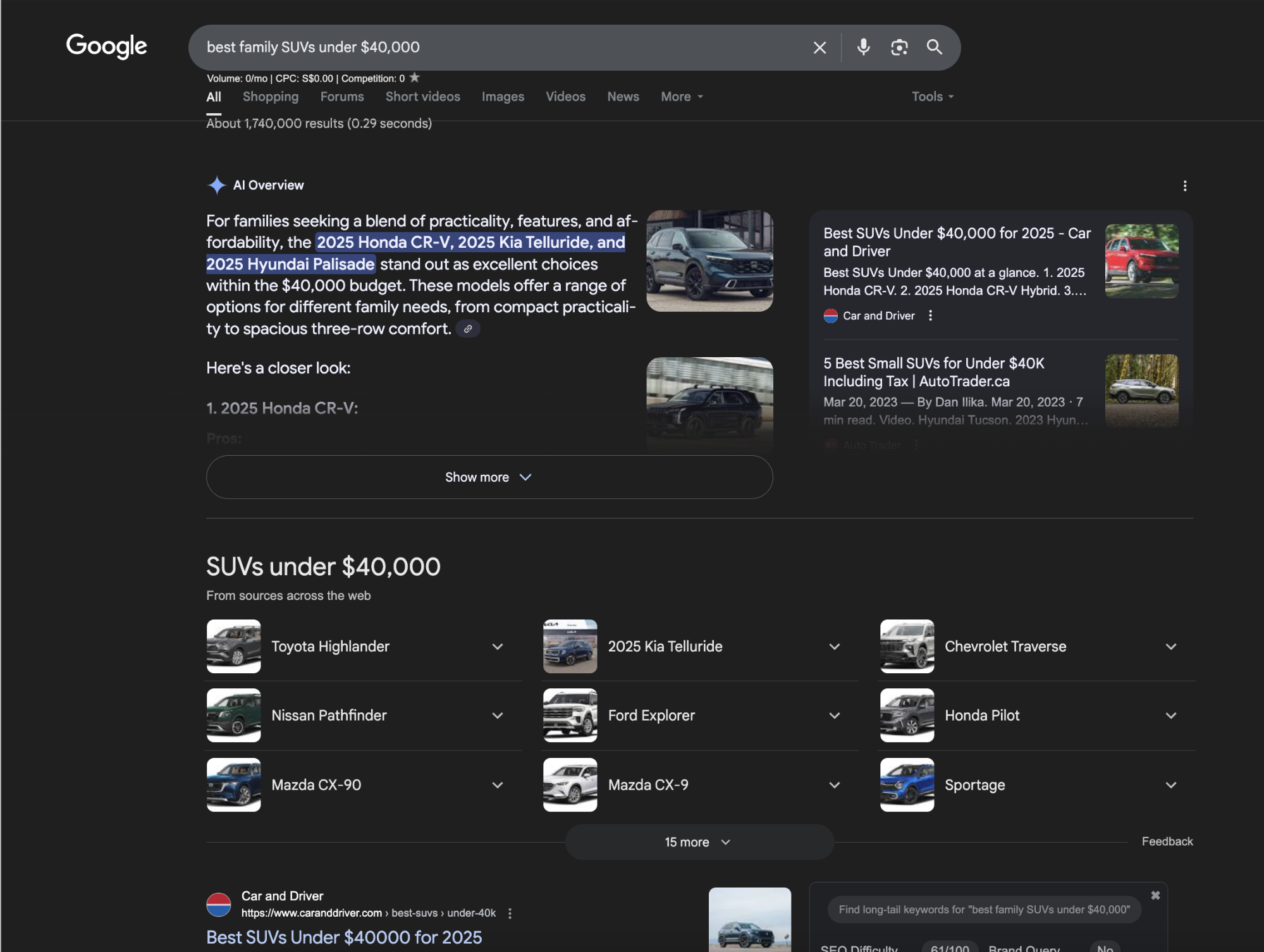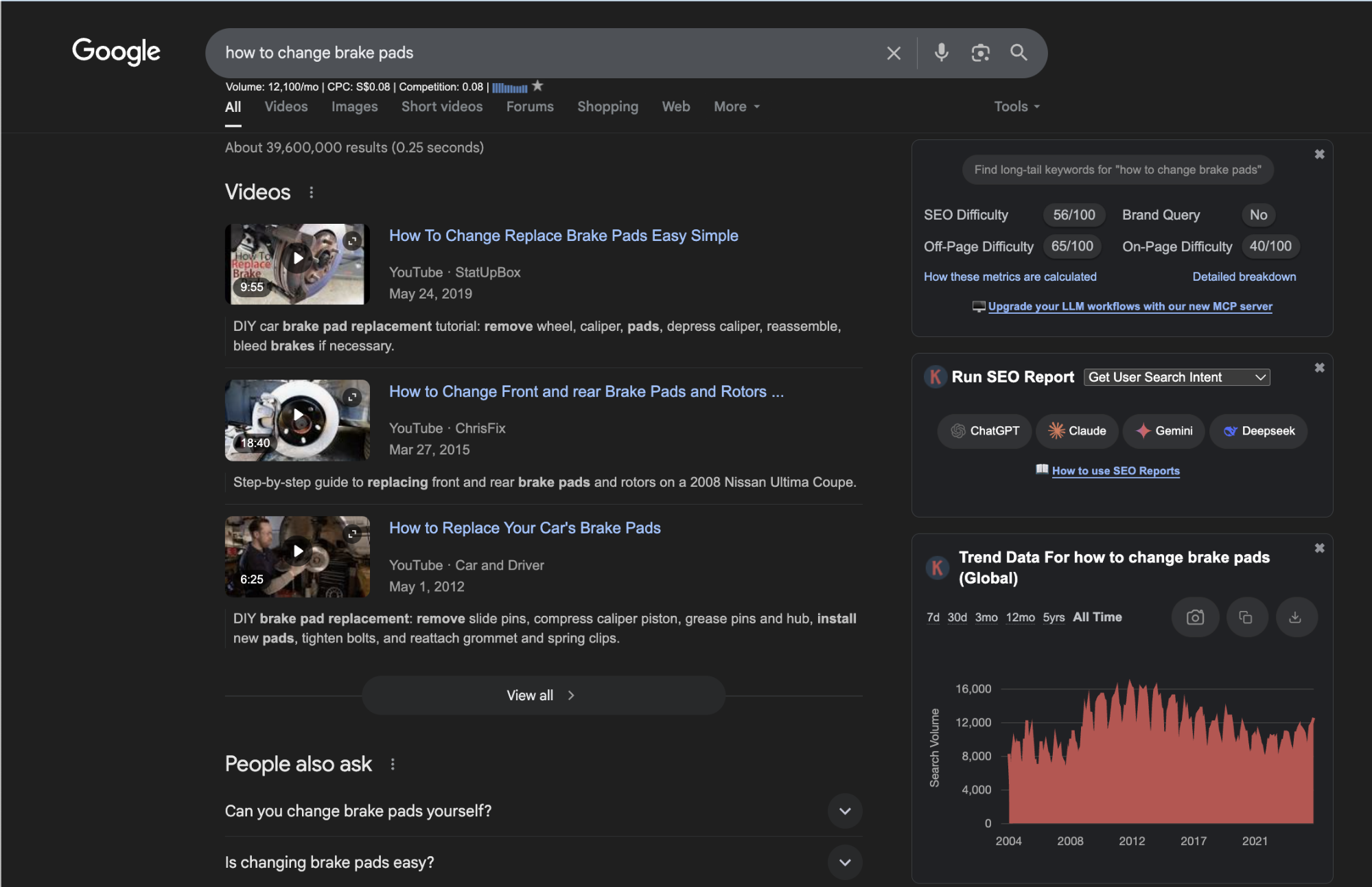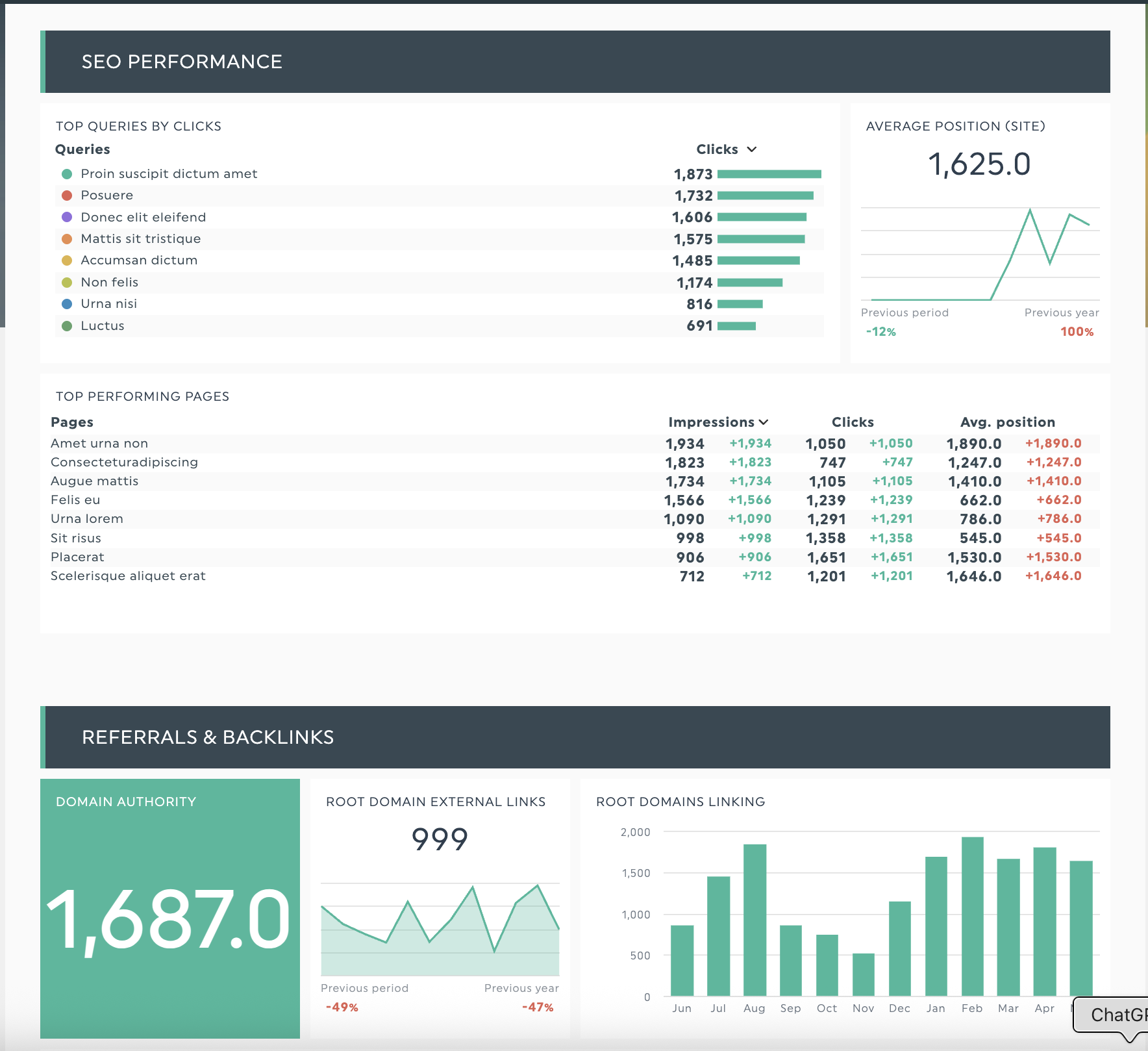How to Perform SERP Analysis and Report Results to Clients
Is your current search engine results page (SERP) analysis process a mess? Maybe your team does it differently every time, clients get inconsistent insights, or you’re starting from scratch for every keyword audit.
Or maybe you’ve noticed AI overviews and changing algorithms are affecting your organic search traffic or click-through rates (CTR), pressuring you to adjust how you analyze and explain Google SERP data to your clients.
In this guide, we’ll walk you through a structured process for conducting your SERP analysis to support your proposed search engine optimization (SEO) strategy and share your findings with your client using DashThis.
Table of contents
- What is SERP analysis?
- How to do a SERP analysis — step by step
- Make SEO reporting easier with DashThis
What is SERP analysis?
SERP analysis is the process of examining Google's organic search results for a specific keyword or search term. You'll evaluate elements like:
- Search intent: What do users want when they search this term?
- Competitor strategy: What helps pages reach the top position?
- Content gaps: What helpful information could you add?
- Keyword relevance: Does this keyword align with your business goals?
- Ranking opportunity: How hard would it be to outrank competitors?
This process involves in-depth keyword research and determining the content needed to match the search intent of a keyword.
Here’s an example of how SERP analysis looks like.
When planning content for an automobile dealership around the keyword 'best family SUVs under $40,000,' you'd perform a SERP analysis to understand the top-ranking pages, identify SERP features like People Also Ask boxes, and spot content gaps.

Done correctly, this analysis shapes your SEO strategy. It turns raw SERP data into a clear action plan to help clients rank in search results. Better yet, it ties search performance to metrics your clients value: lead generation and revenue growth.
How to do a SERP analysis — step by step
Not sure how to conduct a SERP analysis? This guide shows you how to assess search intent, spot content opportunities, and create clear reports for clients.
Step 1: Determine search intent for your target keyword
Search intent answers the question: “What does someone want to find with a specific search term?” People may seek information, aim for a specific website, want to buy something, or compare products.
Match your target keyword to your client's business goals. You risk wasting effort if you focus on research-based keywords when your client needs to drive sales through organic search traffic.
A content plan for an automobile dealership should address different customer needs. Here are some examples of intent types to consider:
| Intent type | What the user wants to do | Example searches | What Google shows you | Words you’ll see in titles |
|---|---|---|---|---|
| Navigational | Find a specific brand or web page | "Toyota dealership near me" |
|
_ Brand names _ Location terms |
| Informational | Seek knowledge about a topic | "How to change brake pads" |
|
|
| Transactional | Ready to make a purchase | "Buy 2024 Honda Civic" |
|
|
| Commercial | Research products before buying | "Best SUVs under $30,000" |
|
|
Getting this wrong means your high-quality content will struggle to rank. As Firdaus Syazwani, the Founder of the Dollar Bureau, shares,
“The biggest mistake I consistently see is agencies creating transactional content when users clearly seek informational answers. Misalignment between intent and content type inevitably leads to poor rankings and frustrated clients. Agencies often overlook that SERP results themselves are the clearest indicator of search intent. Understanding intent transformed my content strategy entirely. For instance, realizing a high-volume keyword I was targeting was informational rather than transactional led me to pivot from direct selling to providing valuable, detailed resources. This shift not only boosted organic visibility but also significantly enhanced brand authority and trust.”
Follow these steps to understand search intent.
- Review the top 3 results: are they how-to guides, product pages, or comparison articles? This will help you understand what type of content fulfills search intent.
- Analyze search result displays: Look for shopping boxes, information panels, or video collections to understand if searchers prefer quick definitions, video content, or product listings.
- Study ranking titles: Are they guides, recommendations, or purchase-focused? The language patterns reveal what content Google matches to searcher needs.
Beyond understanding search intent, examine what your target audience seeks when they search.
Consider your audience’s perspective. Understanding who’s searching for this information and their motivations will help you create content that addresses their needs.
For the informational query "how to change brake pads," consider whether written instructions or a video demonstration would be more valuable. Prioritizing video content or combining video with text would better fulfill search intent.

Google prioritizes video content over text links for this search query
Ask yourself: Does this search query align with your business goals? High search volume doesn't guarantee relevance.
In our automobile dealership example, if their focus is selling new and used vehicles to local families, the priority should be attracting qualified leads interested in purchasing or leasing cars. While the search query 'how to change brake pads' shows high volume, it primarily draws DIY car owners seeking repair tutorials rather than prospective buyers researching their next vehicle purchase.
Instead, your content creation resources would be better spent on queries like 'best family SUVs under $40,000' or 'Honda vs Toyota reliability comparison' that align with your dealership's sales goals and attract actively shopping customers.
After identifying the best keywords for your client's business, audience, and content goals, move to the next phase.
Step 2: Review current organic rankings and SERP features
Check what appears when people search your target keyword — regular search results and special Google features like snippets or PAA boxes. Using SEO tools like Ahrefs, Moz, or SEMrush will help you understand the current rankings and ranking factors.
Search rankings once relied on keyword-specific link listings to drive clicks. But as Google introduced SERP features and AI overviews, search behavior has shifted toward accessing information directly within search results.
Data supports this. 2024 data from SparkToro shows 58.5% of searches end without clicking any results. According to Ahrefs analysis, AI overviews cut clicks to informational content by another 34.5%. This makes SERP features visibility equally important.
Key areas to watch include:
Content and formatting patterns
Do top results favor long-form guides, listicles, or instructional pieces? Pay attention to:
- Word count and coverage depth
- Heading and subheading patterns
- Images, diagrams, and media elements
- Whether content speaks to newcomers or advanced practitioners
This analysis aligns your writing with audience expectations and competitive standards.
SERP features
Examine how different SERP features match search intent. Featured snippets pull structured answers from content, while PAA sections reflect common user questions. When displaying AI-generated summaries, search engines reference trusted sources. Visual elements appear through carousels and image collections, with local pack results highlighting nearby businesses based on user location.
After analyzing your findings, identify recurring competitors in multiple SERP features and study rich snippet patterns to spot content positioning opportunities.
Prioritize strategically. A small local business should focus on local pack results (location-specific SERP features) rather than competing with major publications for featured snippets, while a SaaS company might prioritize FAQ schema to capture People Also Ask boxes in their niche.
When presenting these strategic choices to clients, focus on the why behind your recommendations rather than technical details. For example, instead of explaining FAQ schema markup, show your SaaS client how appearing in 'People Also Ask' boxes positions them as the authority when prospects research solutions.
This information can confuse clients, but it’s best to keep it simple and get straight to the point. As Borets Stamenov, Co-Founder & CEO, SeekFast.org says:
Clients want wins, not SEO lectures. Ditch the jargon—just show two screenshots: one with the top results, one with their page. Highlight exactly what’s ranking—guides, videos, communities—and lay out the roadmap from there. When clients see the reality, buy-in comes fast.
Step 3: Look for gaps and opportunities to differentiate your content
During your competitive analysis, identify where you can outperform existing results. Look for unmet user needs, missing information, or fresh angles for your audience. This creates openings to:
- Build trust by citing original data industry studies or expert interviews
- Repurpose content into different formats, like adapting a written tutorial.
- Revise your content to match your audience’s needs.
- Refine user experience compared to your competitor’s content
Content optimization tools like Clearscope reveal keywords that strengthen your writing. Want insights for better content marketing? Try these approaches:
Do external research:
Review platforms such as Reddit, YouTube comments, and review aggregators including TrustPilot, G2, and Capterra (for B2B SaaS) provide valuable insights into user needs and questions. Pay attention to recurring questions left unanswered, requests for clarification, and users sharing personal experiences or problem-solving approaches.

For example, let’s say your client is selling CRM software and looking for content ideas for a particular keyword.. This Reddit discussion reveals insights about alternatives to free CRM software for sales teams. The comments show how teams manage without a CRM and could spark ideas for comparing different solutions or determining when to invest in a full CRM system.
Mine your internal data
Ask your customers, refer to recent conversations with clients or customer conversations. Review customer conversations, support tickets, and client feedback to uncover opportunities for targeted content. These real-world insights can inspire new landing pages or help expand existing content with relatable examples.
You might begin with:
- Customer support tickets and common customer questions to spot content opportunities that could prevent future inquiries.
- Questions prospects ask and objections during sales conversations.
- Friction points during customer onboarding
- Customer surveys and feedback forms to learn if your content connects with your audience and discover what topics interest them most.
Incorporate fresh perspectives or unique data
Find outdated statistics, expired research, or old case studies that you could refresh with current information. Many high-ranking articles use old data; you can stand out by offering fresh, current research. By using fresh data, you could create a superior piece with current statistics, expert insights, and real performance data from your own client work. This approach provides more relevant, actionable insights that better serve today's search intent.
Step 4: Document your findings and create an action plan
The previous three steps involved extensive research, but now it’s time to put it all together and make it actionable for your client. Here’s a clear way to organize your findings.
Create a scoring framework to identify key opportunities
You've identified multiple SERP ranking opportunities through your research, but which ones matter most to your client? Use a scoring system to build targeted campaigns around those terms.
Moattar Ali, VP of Marketing at HARO Link Builder, uses a weighted scoring approach to prioritize opportunities.
“My priority system is a three-pillar scoring: Search Volume Impact (40%), Competitive Difficulty (35%), and Client Resource Requirements (25%). Each SERP opportunity is rated 1-10 in these areas to yield a weighted priority score. Opportunities of 8.0 and above are given priority focus, 6.0-7.9 are scheduled for the quarterly roadmap, and below 6.0 are long-term.
The secret lies in the "Quick Win Identification" process, where I find high-volume keywords where the competition has poor content gaps. It doesn't require many resources but can bring fantastic ranking wins within 30-60 days.”
This systematic approach keeps you focused and prevents you from overwhelming clients with too many opportunities at once.
Structure your SERP analysis with these actionable steps:
- Build a ranking system that aligns with your client’s priorities
- Focus on three key opportunities per client presentation
- Start with small victories
- Separate Immediate Actions from Quarterly Planning to make reports more understandable.
Create your action plan with progress checkpoints
Take the scoring and prioritization data and organize your findings into a clear action plan. As Moattar explains, breaking opportunities into distinct phases creates more actionable reports.
I apply a "Three-Tier Revelation" strategy when unveiling competitive results. Tier one addresses short-term opportunities that require low investment. Tier 2 introduces medium-term options that require moderate resources. Tier 3 uncovers long-term competitive strengths that demand high commitment.
Every phase receives a maximum of three recommendations with concrete ROI expectations and timeline commitments. This avoids information overload; clients can see quick wins and strategic potential. However, I have realized; clients can only effectively absorb nine recommendations, not to mention the complexity of the analysis.
Use this framework as a reference point while working on your client’s SEO initiatives.
Track SEO progress with DashThis
Once you've organized your findings into this structured action plan, the next challenge is monitoring if your SERP optimization efforts are actually working. This is where tracking becomes crucial.
In our automobile dealership example, after implementing your "best family SUVs under $40,000" content strategy, track if you're climbing to position #3, check if your FAQ schema captures People Also Ask boxes, and measure how well your content fills gaps and drives engagement.
Instead of switching between multiple SEO tools, DashThis combines your data into one automated dashboard to track your rankings against competitor benchmarks. You can monitor:
- Ranking progress against competitors
- SERP feature wins like featured snippets, PAA boxes, AI overview citations
- Backlink growth over time, like referring domains and growth trends
- Content performance metrics like scroll depth, engagement time, and session duration in GA4 help track user interaction with your optimized page.
DashThis connects directly with Google Search Console, GA4, and Ahrefs, letting you track these metrics in a single dashboard.

Get this SEO report with your own data!
You can annotate your DashThis charts to explain ranking improvements, making it clear to clients how specific changes boosted their search performance and organic traffic.
Make SEO reporting easier with DashThis
This step-by-step guide gives you a clear framework to understand user intent, identify SERP opportunities, and track progress with automated reporting. Instead of juggling multiple tools and manual processes, you'll have a streamlined approach that turns your SEO strategies into measurable results clients can easily follow.
Ready to start tracking your SERP optimization results with DashThis? Try it free for 15 days to automate your SEO reporting and track your SEO ranking progress over time.
Automate your SEO reporting with Dashthis today!
Read More
Don’t miss out!
Automate your reports!
Bring all your marketing data into one automated report.
Try dashthis for free

